
Strike on al-Baqa killed a Hamas operative, but many more people were killed
2025-07-04 14:24:27
BBC News, Jerusalem
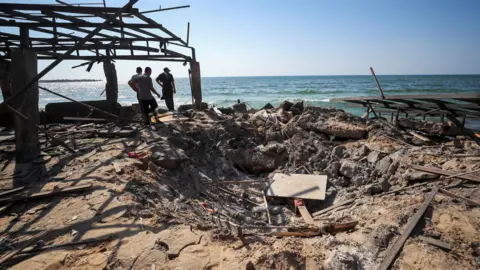 Reuters
ReutersMoments before the explosion, artists, students and athletes were among those gathered at a bustling seaside cafe in Gaza City.
Huddled around tables, customers at al-Baqa Cafeteria were scrolling on their phones, sipping hot drinks, and catching up with friends. At one point, the familiar melody of “Happy Birthday” rang out as a young child celebrated with family.
In a quiet corner of the cafe overlooking the sea, a Hamas operative, dressed in civilian clothing, arrived at his table, sources told the BBC.
It was then, without warning, that a bomb was dropped by Israeli forces and tore through the building, they said.
At the sound of the explosion, people nearby flooded onto the streets and into al-Baqa in a desperate search for survivors.
“The scene was horrific – bodies, blood, screaming everywhere,” one man told the BBC later that day.
“It was total destruction,” said another. “A real massacre happened at al-Baqa Cafeteria. A real massacre that breaks hearts.”
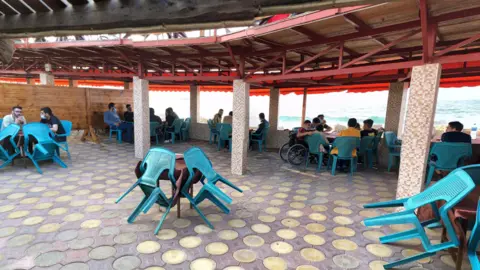 Google
GoogleThe BBC has reviewed 29 names of people reported killed in the strike on the cafe on Monday. Twenty-six of the deaths were confirmed by multiple sources, including through interviews with family, friends and eyewitness accounts.
At least nine of those killed were women, and several were children or teenagers. They included artists, students, social activists, a female boxer, a footballer and cafe staff.
The conduct of the strike and the scale of civilian casualties have amplified questions over the proportionality of Israel’s military operations in Gaza, which the Israel Defense Forces (IDF) say are aimed at defeating Hamas and rescuing the hostages still being held by the group.
Family members in Gaza and abroad spoke to the BBC of their shock and devastation at the killings.
“We were talking with each other two days ago. We were sending reels to each other. I can’t believe it,” said a young Palestinian man living in the US whose 21-year-old “bestie” Muna Juda and another close friend, Raghad Alaa Abu Sultan, were both killed in the strike.
The numbers of deaths analysed by the BBC were broadly consistent with figures given by the Hamas-run Civil Defence Agency, a senior local medic and the Palestinian Red Crescent in the days after the strike.
Staff at Shifa Hospital, which received the bodies, said its toll as of Thursday had reached 40 deaths, including people who had succumbed to their injuries, and unidentified bodies.
An official at the hospital said some of the bodies had been “blown to pieces”, and that 72 injured patients were brought there – many having sustained severe burns and significant injuries that required surgery. He said many were students.
In a statement after the strike, the IDF said it had been targeting “terrorists” and that steps were taken to “mitigate the risk of harming civilians using aerial surveillance”.
“The IDF will continue to operate against the Hamas terrorist organization in order to remove any threat posed to Israeli civilians,” it added, before saying the “incident” was “under review”.
The IDF did not directly respond to multiple BBC questions about the target of the strike, or whether it considered the number of civilian casualties to be proportionate.
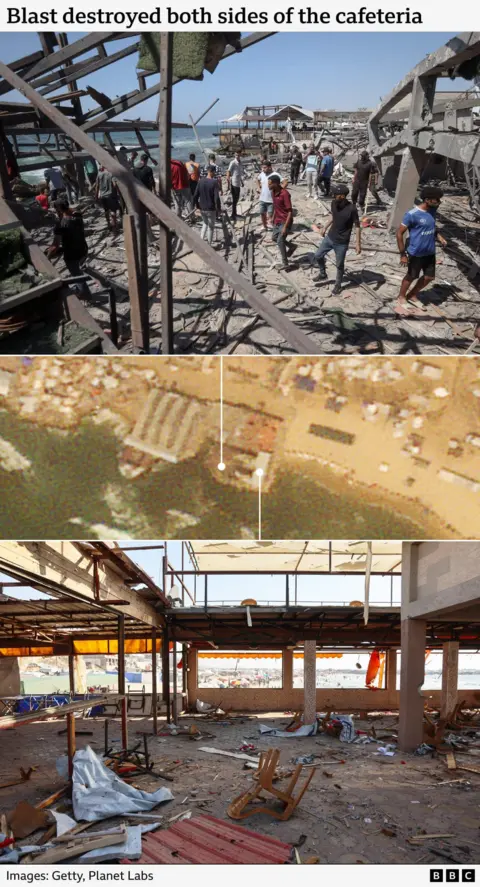
Al-Baqa Cafeteria was well-known across the Gaza Strip, considered by many to be among the territory’s most scenic and vibrant meeting spots.
Split over two floors and divided into men’s and mixed family sections, it had views out to the Mediterranean Sea and television screens where people could watch football matches. It was a place to gather for coffee, tea and shisha with friends, and was a particular favourite with journalists.
Al-Baqa had remained popular even during the war, especially because of its unusually stable internet connection. The cafe, which had until now survived largely unscathed, also served up a reminder of the life that existed before the bombardments.
A cafe manager told the BBC that there was a strict entry policy. “It was known to our customers that if any person looked like a target, then they were not let inside the cafeteria – this was for our safety and the safety of the people there,” he said.
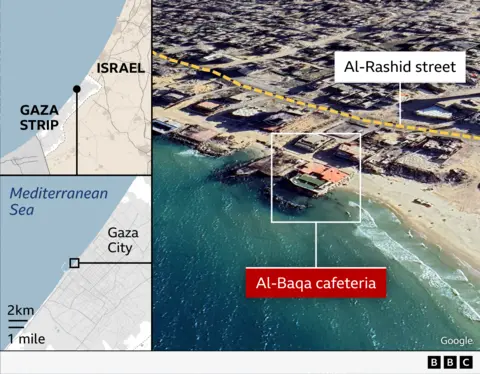
On the day of the strike, the port area of Gaza City where the cafe is located was not under Israeli evacuation orders, and families of those killed on Monday say they had felt as safe as is possible when heading there.
Staff told the BBC that the strike in the early afternoon – between the Muslim prayers of Zuhr and Asr – was outside of the cafe’s busiest hours.
The strike hit a section of the men’s area where staff said few people were at the time.
BBC Verify showed several experts photos of the crater left in the wake of the explosion and the remaining munition fragments. Most said that they believed it was caused by a bomb, rather than a missile, with a range of size estimates given, at a maximum of 500lb (230kg).
The IDF told the BBC it would not comment on the type of munition used.
A journalist who was in the area at the time of the strike and spoke to eyewitnesses immediately afterwards told the BBC the munition that hit the cafe “was launched from a warplane – not from a drone that would usually target one or two people… It looked like they were very keen on getting their target”. His account was consistent with others we spoke to.
Twenty-seven-year-old Hisham Ayman Mansour, whose deceased father had been a leading figure in Hamas’ military wing, the al-Qassam Brigades, was among those in the men’s section by the sea.
His brother was previously killed by Israeli forces, and one social media post mourning his death suggested the brother had taken part in the 7 October 2023 attacks.
A local Hamas source said Hisham was the target of the strike, and described him as a field commander with the group, a “mid-ranking role”.
Tributes posted on social media also referred to him as a “fighter” and “member of the resistance”. His cousin also described him to the BBC as a “fighter” with the proscribed group, but said he thought he was “low-level” and not currently active.
It is unclear what he was doing in the cafe that day, with two sources telling the BBC he was believed to be there for a “money drop”, while another suggested he was there for “coffee and a short respite” and that he had not been involved in “militant activities” during the war.
A photo shared on social media purported to show Hisham at the same spot in the men’s area of the cafe the day before the strike, wearing a cap and sports t-shirt. Photos of his body after the strike in the same outfit were shared by family and friends.
Two members of his family – one of them a child – were also killed.
The IDF would not confirm whether Hisham was the primary target, or one of a number of targets of the strike.
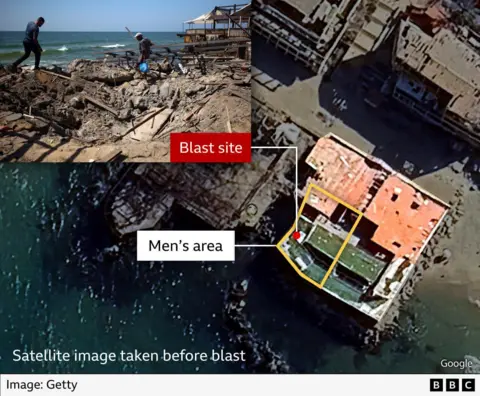 Getty, Google
Getty, GoogleOne former senior IDF official told the BBC he understood that “multiple Hamas operatives” were hit at the cafe, but that a so-called battle damage assessment was still ongoing. A source with Israeli intelligence connections pointed towards a social media post naming Hisham as the target.
Sources in Gaza gave the BBC the name of a more senior Hamas commander who was rumoured to have been seated on a nearby table, but posts on social media said he died the following day and did not mention the cafe.
The Hamas source said Hisham was the only person within the group killed at al-Baqa, while the IDF did not respond to questions about the commander.
An anti-Hamas activist told the BBC that “many Hamas people” were injured in the strike, including one who worked with the group but not as a fighter, who lost his leg in the explosion.
Medics could not confirm this account, but said that they dealt with many people with severe injuries, including those arriving with missing limbs or requiring amputations.
Israel does not allow international journalists access to Gaza to report on the war making it difficult to verify information, and Hamas has historically ruled the territory with an iron grip, making speaking out or any dissent dangerous.
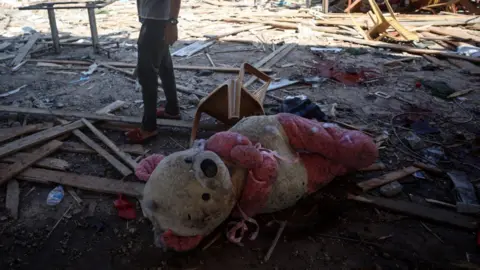 Getty / NurPhoto
Getty / NurPhotoThe remainder of this article contains details some readers may find distressing.
Among the bodies and the debris in al-Baqa were traces of the civilian lives lost – a giant pink and white teddy bear, its stuffing partially exposed, a child’s tiny shoe, and playing cards soaked in blood.
A displaced man who was in the area seeing family at the time of the strike was among those who went running into the cafe to try to find survivors.
“Shrapnel was everywhere… there were many injuries,” he told the BBC.
He said when he entered part of the men’s section that he found the bodies of waiters and other workers, and saw as one “took his last breath”.
“It was crazy,” said Saeed Ahel, a regular at the cafe and friend of its managers.
“The waiters were gathered around the bar since it was shady and breezy there. Around [six] of them were killed,” he added, before listing their names. More were injured.
The mother of two young men who worked at the cafe screamed as she followed their bodies while they were carried on a sheet out of the wreckage on Monday.
A distraught man pointed at a dry patch of blood on the floor, where he said bits of brain and skull had been splattered. He had put them in a bag and carried them out.
Meanwhile, the grandmother of 17-year-old Sama Mohammad Abu Namous wept.
The teenager had gone to the cafe that afternoon with her brother, hoping to use the internet connection to study. Relatives said the siblings were walking into the beachside cafe when the bomb hit. Sama was killed, while her brother was rushed to hospital.
“She went to study and they killed her,” she said. “Why did she have to return to her grandmother killed?”
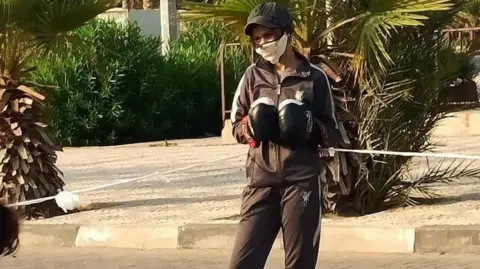 Palestinian Olympic Committee
Palestinian Olympic CommitteeThe coach of young female boxer Malak Musleh said he was in shock at the loss of his friend of more than 10 years, having first learned the news of her killing through social media.
“She believed that boxing was not just for boys but that girls should have the right too,” Osama Ayoub said. “Malak was ambitious. She didn’t skip any training day.”
He said he last saw Malak about 10 days before the strike, when he dropped off some aid to her and her father.
“We sat together for nearly an hour. She told me that she was continuing her training with her sister and wished I could train them. I told her unfortunately because my house got demolished I live now in Khan Younis [in southern Gaza], but as soon as I hear that there is a ceasefire I will try to go back to training,” he said.
“She said to make sure to keep a space for them… She had passion in her eyes and her words.”
When Osama saw the Facebook post by Malak’s father announcing her death, he “didn’t believe it”.
“I called him and he confirmed it but I still don’t believe it,” he said over the phone from a displacement camp.
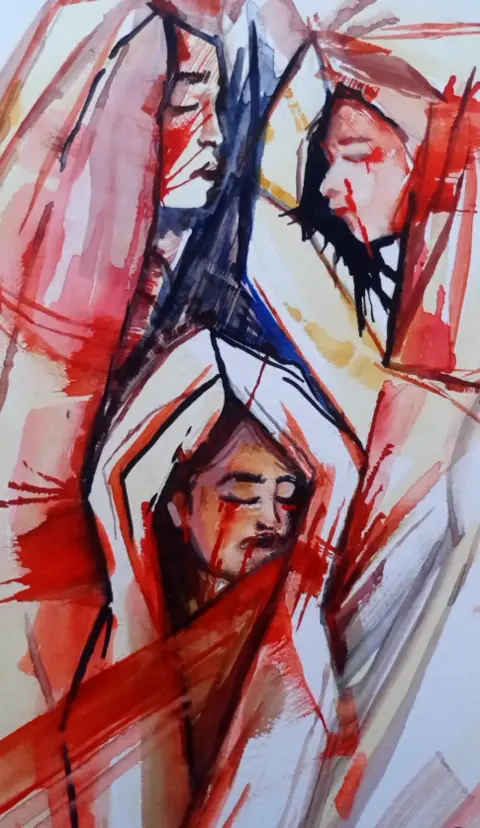 Instagram/@francalsalmi
Instagram/@francalsalmiArtist Amina Omar Al-Salmi, better known as Frans, was also at the cafe with a well-known photographer friend.
Since the 35-year-old’s death, one of her pieces depicting a dead woman with her eyes closed and covered in blood, has been shared widely online alongside an image of her after her death, with people noting the striking similarities.
Her sister, now living in Sweden, told the BBC that the last time they spoke, Frans had said that she was sure “something good was going to happen”.
“She was happy and said: ‘We’ll meet soon. You’ll see me at your place.'”
Additional reporting by Riam El Delati and Muath al-Khatib
Verification by Emma Pengelly and Richie Irvine-Brown
https://ichef.bbci.co.uk/news/1024/branded_news/f872/live/9d249e60-5723-11f0-960d-e9f1088a89fe.jpg










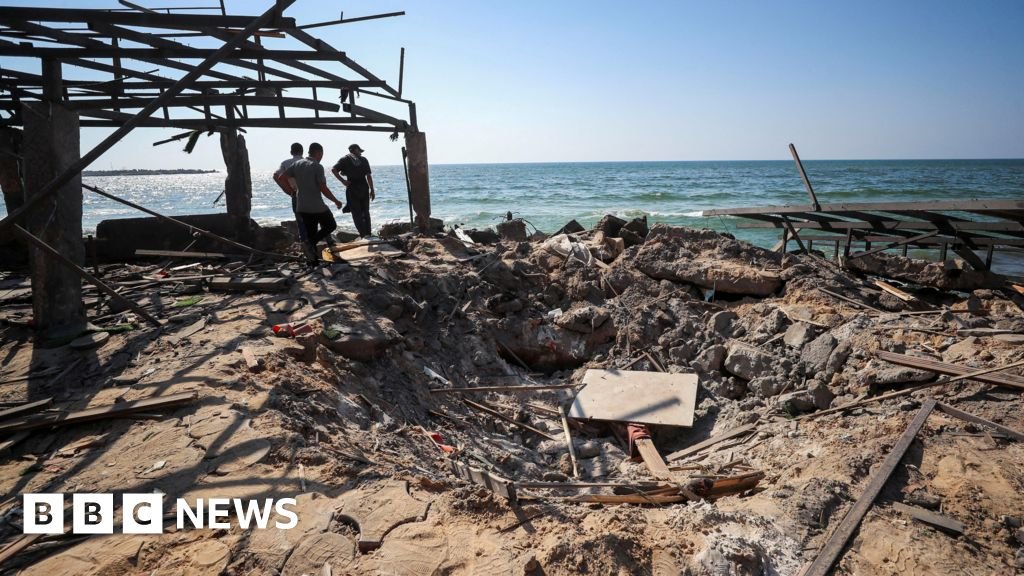

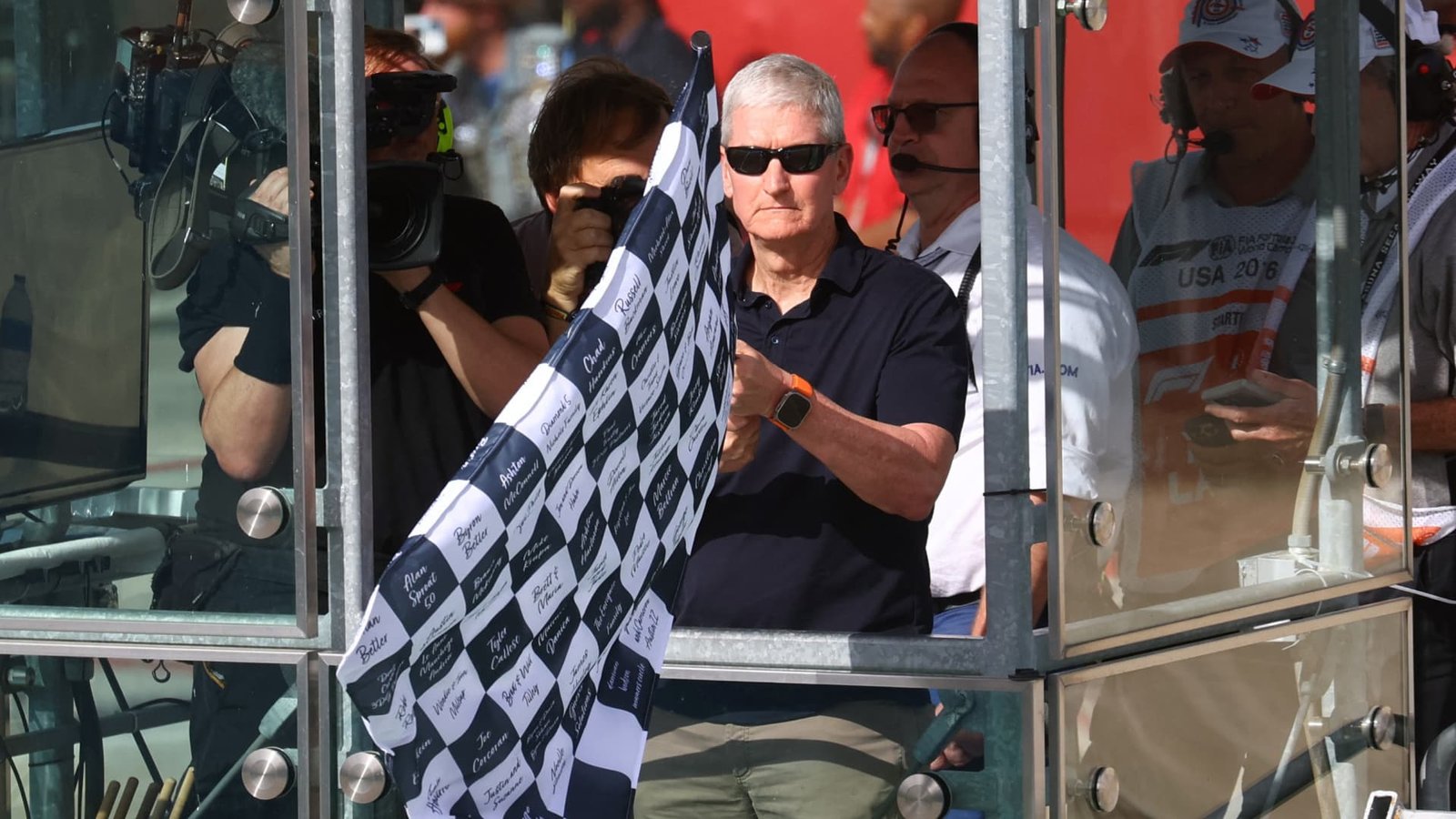
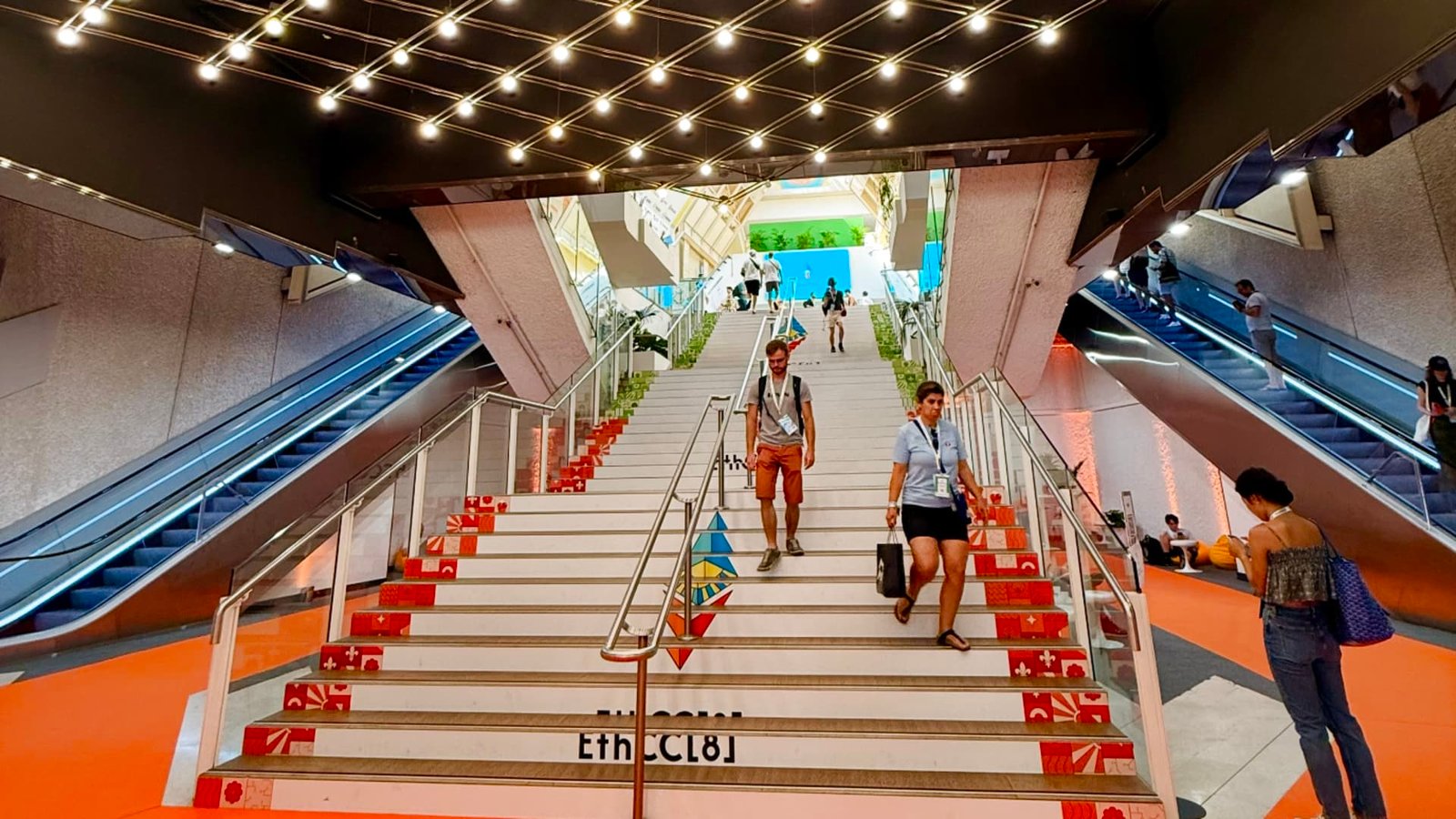
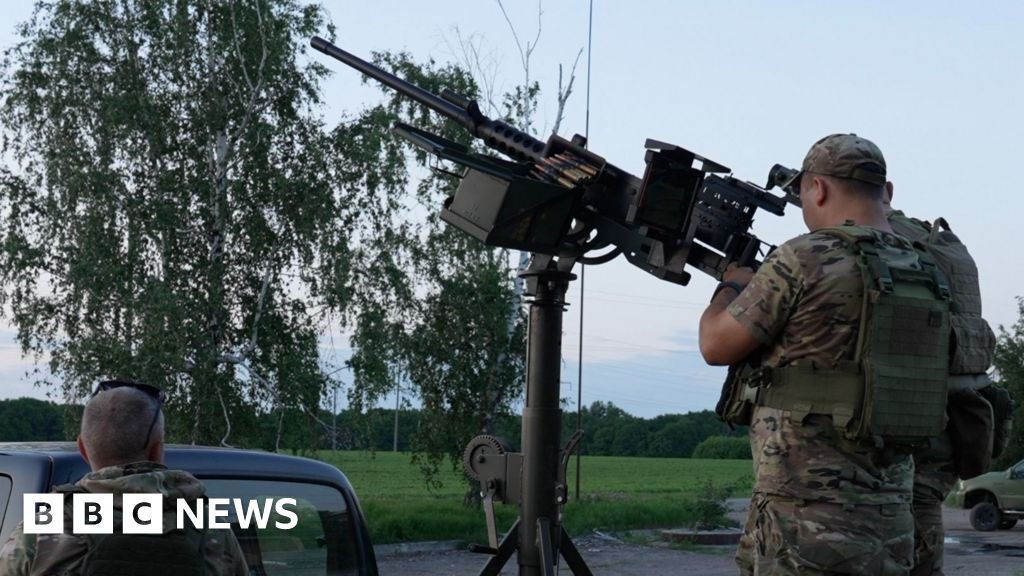
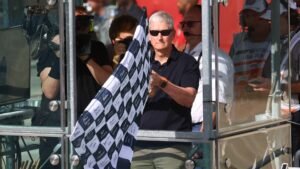
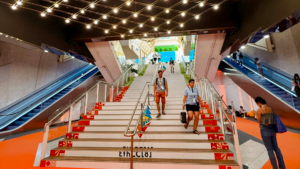
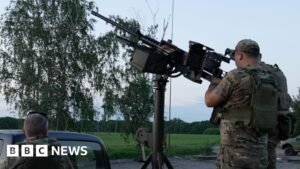
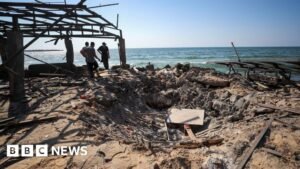

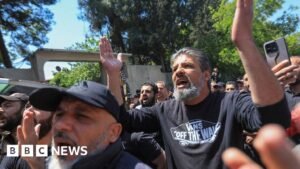

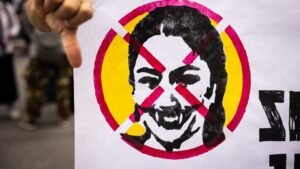
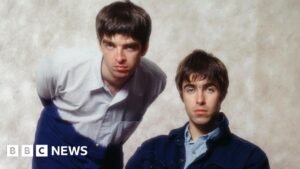


Post Comment